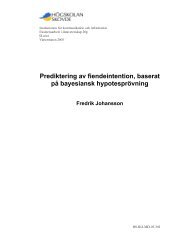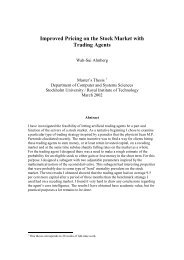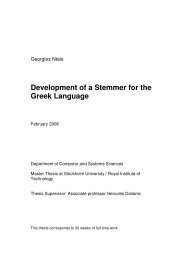Modeling Hydra Behavior Using Methods Founded in Behavior-Based Robotics
Modeling Hydra Behavior Using Methods Founded in ... - SAIS
Modeling Hydra Behavior Using Methods Founded in ... - SAIS
You also want an ePaper? Increase the reach of your titles
YUMPU automatically turns print PDFs into web optimized ePapers that Google loves.
<strong>Model<strong>in</strong>g</strong> <strong>Hydra</strong> <strong>Behavior</strong> <strong>Us<strong>in</strong>g</strong> <strong>Methods</strong> <strong>Founded</strong> <strong>in</strong> <strong>Behavior</strong>-<strong>Based</strong> <strong>Robotics</strong>Master’s Thesis <strong>in</strong> Eng<strong>in</strong>eer<strong>in</strong>g MechatronicsMALIN AKTIUSDepartment of Applied MechanicsDivision of Vehicle SafetyChalmers University of TechnologyAbstractIn this thesis work methods from the field of behavior-based robotics are used to modelthe behavior of a biological organism. The cnidarian <strong>Hydra</strong> was selected as the modelorganism for this project, and the colony-style architecture was chosen as the method tobe used for organiz<strong>in</strong>g the constituent behaviors of <strong>Hydra</strong> <strong>in</strong>to an overall behavior. The<strong>in</strong>dividual behaviors were generated and organized <strong>in</strong> a simulated animal. Validation ofthe <strong>in</strong>dividual behaviors were carried out with respect to quantitative data available frompreviously conducted experiments on the animal. In the case of the overall behavior,which emerged from the organization of the <strong>in</strong>dividual behaviors us<strong>in</strong>g the colony-stylearchitecture, only a qualitative comparison was feasible. Tests conducted on the modeled<strong>Hydra</strong> suggests that the colony-style architecture can be used to model behavior propertieslike latency, activation threshold, habituation, and duration of the <strong>in</strong>dividual behaviors of<strong>Hydra</strong>. Simulations of the overall behavior of the animal show that the spatial movementpatterns of <strong>Hydra</strong> <strong>in</strong> the absence of external stimuli, as well as the effect of starvation onits contraction frequency, agrees with results from experiments conducted on the physicalanimal.Keywords: behavior-based model<strong>in</strong>g, <strong>Hydra</strong>, colony-style architecture, evolutionary algorithms,recurrent neural networks.i





